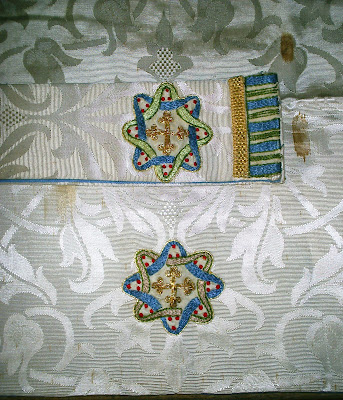Today is Ember Friday in Advent. It ranks as a greater, non-privileged ferial day of simple rite. The Ember Day is outranked by the semi-double feast of the Martyr St. Eusebius. The liturgical colour of the day is red.
At Mattins the invitatory
Regem martyrum Dominum etc is sung and the hymn is
Deus, tuorum militum. In the nocturns the antiphons
Suscitavit Dominus etc are sung with the nine psalms/
divisi given for Mattins of Friday. In the first nocturn the lessons are taken from the Common of Martyrs ,
A Mileto Paulus etc followed by their responsories. In the second nocturn three hagiographic lessons proper to the feast are read. In the third nocturn the homily is from St. Gregory the Great on St. Matthew's Gospel. The ninth lesson is of the Ember Friday and a homily from St. Ambrose on St. Luke's account of the Visitation. The
Te Deum is sung.
At Lauds the antiphons
Exaltate etc are sung with psalms 98, 142, 84,
Vere tu es Deus & 147. The hymn at Lauds is
Invicte Martyr, unicum. After the collect of the feast a commemoration is sung of the Ember Friday with the antiphon on the
Benedictus,
Ex quo facta est etc., the versicle
Vox clamantis etc and respond
Rectas facite etc. The collect is proper to the Ember Friday,
Excita quaesumus etc.
At Prime the Domincial
preces are sung, with the choir standing, and the
lectio brevis is
Beatus vir.
Mass is sung after Terce. The
Gloria is sung, the second collect is of the Ember Friday, the third collect of the BMV in Advent,
Deus, qui de beate. The common preface is sung and the last Gospel is of the Ember Friday.
Private Masses may be of the Ember Friday. There is neither
Gloria nor Creed. The second collect is of St. Eusebius, the third of the BVM in Advent. The common preface is sung and the dismissal is
Benedicamus Domino.
In Cathedral and Collegiate churches two Masses are celebrated. The feast of St. Eusebius is celebrated after Terce. The
Gloria is sung, the second collect is of the BVM,
Deus, qui de beate, and the third collect for the Church,
Ecclesiae. The common preface is sung and the last Gospel is
In principio. Mass of the Ember Friday is sung after None. The ministers wear violet folded chasubles and four candles are on the altar. The Mass is proper. The second collect is of the BVM,
Deus, qui de Beate, and the third collect for the Church,
Ecclesiae. The choir kneels for the orations and from the Canon through to the Fraction as is usual on penitential days. There is no Creed and the common preface is sung. The dismissal is
Benedicamus Domino sung by the deacon facing the altar.
At Vespers there is a commemoration of the Advent feria. As the Office of the Ember Friday ended at None the commemoration consists of the antiphon on the
Magnificat, Hoc est testimonium etc, the versicle
Rorate caeli etc, its respond,
Aperiatur terra etc and the collect of the preceding Sunday,
Aurem tuam etc. At Compline the Dominical
preces are sung, the choir standing.
Following the 'liturgical books of 1962' the Ember Friday is II class and takes precedence over the III class feast of St. Eusebius (reduced to a single nocturn). At Mattins the three lessons are the homily for the Ember Friday from St. Ambrose. At Lauds the second schema of psalms is used and there is a commemoration of St. Eusebius and the ferial
preces are sung. Although the second schema of Lauds is sung the fourth psalm is not added at Prime and the ferial chapter
Pacem et veritatem is replaced by the festal (!)
Regi saeculorum. The ferial
preces are omitted at Prime and the Hours. At Mass there is no additional collect for the Blessed Virgin or for the Church. The penitential kneeling is reduced. The dismissal is
Ite, missa est and the ministers wear dalmatic and tunicle. One strange feature of 1962 Ember Wednesdays and Fridays is that whilst traditionally the Ember Day liturgy ended with the Mass sung after None, in the 1962 books Vespers becomes formally part of the Ember Day. In the traditional rite if Vespers were ferial, the collect from the preceding Sunday was sung as noted above. In the 1962 rite the collect from the Ember Day is used at Vespers, so today
Excita, quaesumus is sung.


















































